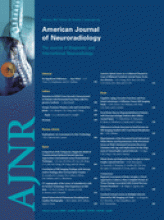Abstract
BACKGROUND AND PURPOSE: 3D-CT angiography (3D-CTA), a vessel-cast technique, is useful in the diagnosis of patients with brain lesions and cerebrovascular disease. However, it provides no information on blood-flow dynamics. Therefore, we developed a new technique, dynamic 3D-CTA (d3D-CTA), that yields 3D images of the vasculature and allows assessment of the hemodynamics and of the cerebral perfusion.
METHODS: We subjected 12 patients to d3D-CTA; 7 had brain tumors, 4 had arteriovenous malformations (AVMs), and 1 presented with cervical internal carotid artery occlusion. d3D-CTA was performed with a multidetector-row CT scanner with 64 detectors; the parameters were 0.5-mm section thickness, 0.5 seconds per rotation, 135 kV, and 150 mA. Contrast medium (total volume, 30–35 mL) was injected at 6–7 mL/s; scanning was started after a 5-second delay. Scans were generated with volume-rendering reconstruction and displayed in cine mode.
RESULTS: We succeeded in obtaining d3D-CTA scans in all cases. The scans yielded 3D information on the vascular structures and hemodynamics and on the status of the cerebral perfusion.
CONCLUSION: d3D-CTA facilitates the acquisition of information on the vascular and cerebral dynamic blood flow on 3D-CTA images. Despite the relatively high radiation exposure and contrast injection speed and its limited scan range, this technique is useful for the diagnosis of patients with brain tumors or cerebrovascular disease and for treatment planning.
- Copyright © American Society of Neuroradiology












